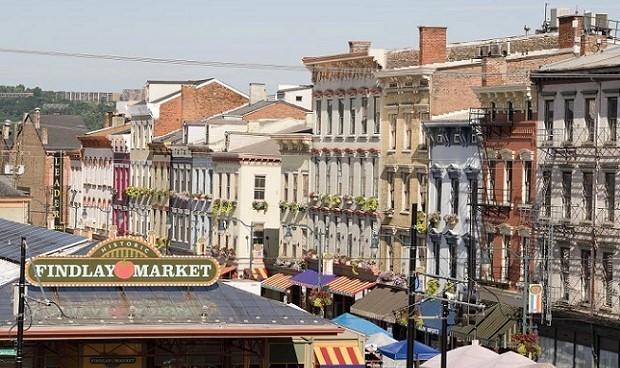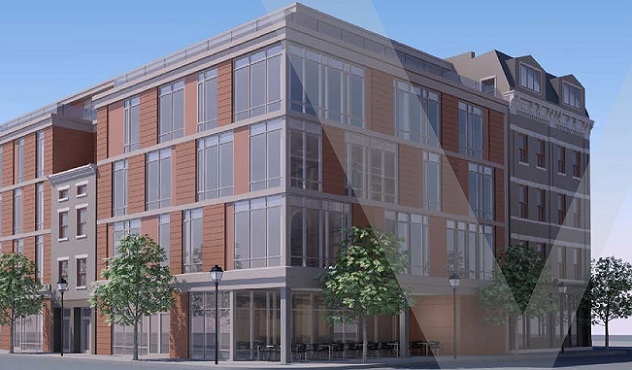 Cincinnati’s Over-the-Rhine neighborhood, founded by German immigrants in the 19th century, is one of the largest historic districts in the US.
Cincinnati’s Over-the-Rhine neighborhood, founded by German immigrants in the 19th century, is one of the largest historic districts in the US.
CINCINNATI—Cities across the US continually search for ways to make their downtowns more attractive, and revitalizing nearby historic areas has been one of the most successful. Cincinnati may provide the best example of how a neighborhood renaissance can impact a whole city. In the last decade its Over-The-Rhine, settled by German immigrants in the 19th century, has seen more than half a billion dollars of investment, according to new research from CBRE. As a result, it has become the crown jewel of the urban core.
“It’s a historic district with beautiful architecture, but it was considered one of the most blighted parts of Cincinnati up until about ten years ago,” Travis Likes, first vice president at CBRE Cincinnati, tells GlobeSt.com. And many worried that a blighted neighborhood so close to the CBD would short-circuit any chance to revive the city.
But Cincinnati was faced with an obstacle met by other cities contemplating similar efforts. Some Over-the-Rhine buildings may have had a scruffy charm, but the rents garnered were far below what was needed to fund rehabs, says Likes. More often, demolition and new construction would have been the economical choice. The city, along with many corporate partners, decided to step in and spark a renaissance that would also preserve neighborhood history.
In 2003, Mayor Charlie Luken created the Cincinnati Center City Development Corp., commonly known as 3CDC, a nonprofit developer, and stocked it with the region’s corporate elite. A.G. Lafley, chief executive officer of Procter & Gamble, the city’s top company, agreed to chair the group. Participating companies, which also includes Kroeger and Fifth Third Bank, kicked in tens of millions to support the effort, and 3CDC also used tax incentives and federal tax credits to leverage more funding.
“They went block by block,” says Likes, and started buying rundown properties, more than one hundred by now. The 360-acre neighborhood, one of the largest historic districts in the US, now bustles with commerce. New bars and restaurants line the streets, and tech firms have settled there, drawn by the renovated buildings that younger employees seem to prefer over glass office towers. “It is easily one of the hottest areas in Cincinnati.”
One key to the success was 3CDC’s nonprofit status, he adds. “When they develop a building, it’s for the betterment of the community.”
 The Over-the-Rhine neighborhood is also seeing new development, including this 42K SF speculative office building that will incorporate some historic structures.
The Over-the-Rhine neighborhood is also seeing new development, including this 42K SF speculative office building that will incorporate some historic structures.
Office rents have soared in response. “Class A office towers in the CBD currently lease for $13,” Likes says, but in Over-the-Rhine, “class A office space regularly leases for $22 to $24. We’re finding that more and more groups are willing to pay.”
And the change has made downtown itself more attractive, he adds. “This was very much a daytime community,” but now workers from the CBD also flood into Over-the-Rhine in the evenings and weekends to enjoy nightlife spots and renovated park spaces.
GE recently established a global operations center in a new 12-story, class A office building in downtown Cincinnati, he points out. “The amenities associated with Over-the-Rhine helped that decision.”
All of this activity also helped the neighborhood reach a tipping point. Other developers, including ones in the office, multifamily and condo sectors, now see it as a desirable place to do business. Currently, according to CBRE, builders have 220,000 square feet of Over-the-Rhine office space under construction.
3CDC has received criticism. Some neighborhood residents say they have not been consulted about all the changes, and worry what will happen when the developer begins moving into the northern half of the district.
Likes believes other municipalities should study the history of 3CDC, especially if they have rundown historic districts where rental rates can’t fund needed renovations. “You have to figure out a way to bridge that gap. Something like 3CDC is a good step for cities that want to get to the next level.”

















 Copyright © 2024 ALM Global, LLC. All Rights Reserved.
Copyright © 2024 ALM Global, LLC. All Rights Reserved.